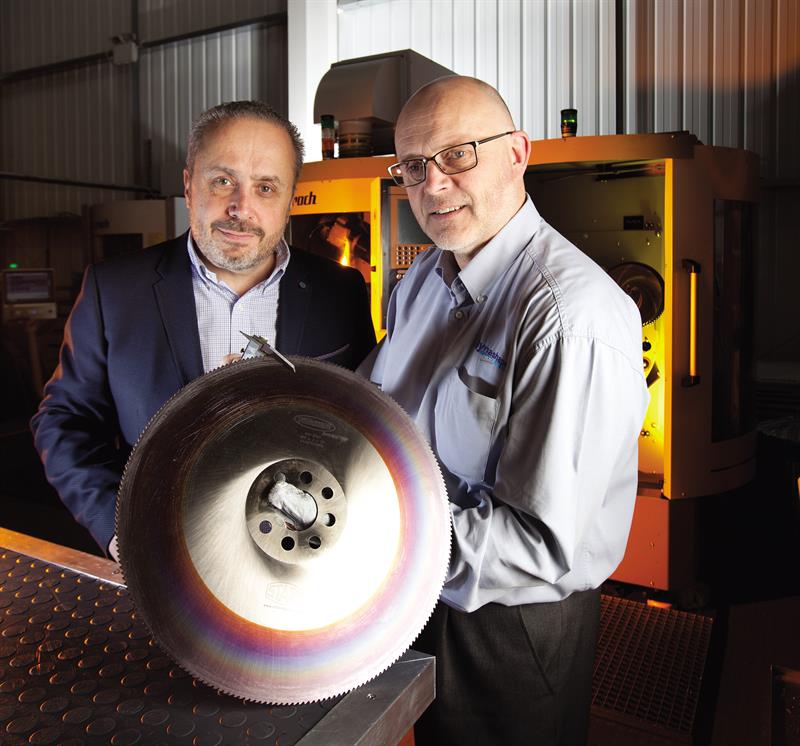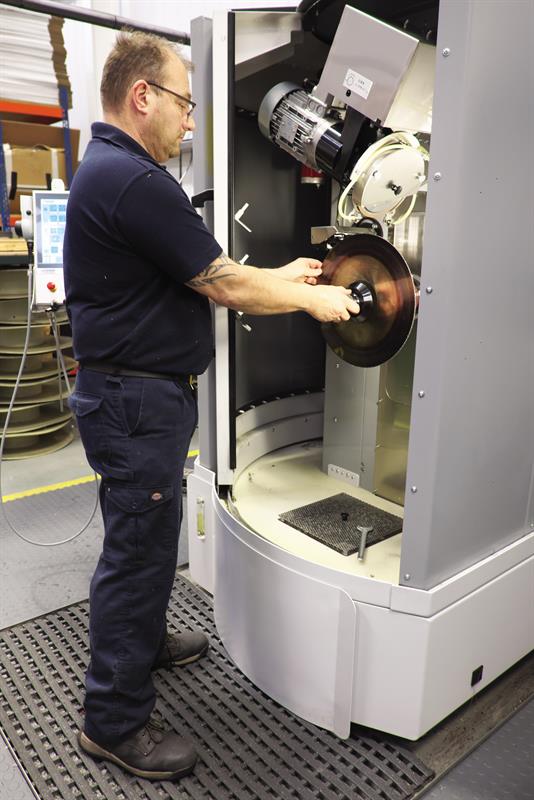Sawing machines and saw blades are Addison Saws’ and its saw blade servicing sister operation Dynashape’s stock in trade, with the companies claiming hundreds of man-years of related knowledge. Following an investment approaching £1 million in expanded and updated premises, as well as high-tech saw blade processing machinery, the pair aim to capitalise on that knowledge, targeting a Dynashape sales boost of 50% this calendar year, mainly through increased cold saw blade remanufacturing. In parallel, Dynashape’s knowledge is also informing Addison Saws’ business.
The two companies have long pedigrees – this year marks Addison Saws’ 60th anniversary, while Dynashape also hails from the 1950s. Addison Saws was part of the B Elliott Group machine tool empire, whose roots were in 1900, with current owner and managing director Gary Knight purchasing the business in 2005.
Alongside another sister company, Tubefab (the UK distributor of Taiwanese-made CSM mandrel tube bending equipment, including CNC, hydraulic and all-electric machines), this makes for a 72-employee, £10-12 million turnover operation located at the newly extended Stourbridge, West Midlands site (01384 264950).
Going back to origins, by introducing the very first circular cold sawing machinery to the UK in the 1950s, Addison Saws became a central player in this market and for the associated supply of blades. In the case of blade servicing expert Dynashape, for many years after the 1960s it focused on saw blade tooth geometry plus cutting and clearance angles as the means to improve blade performance, explains its managing director, Chris Parkes, who boasts 38 years with the company.
Dynashape brought bi-metal bandsaws to the UK in the mid-1960s, but won highest prominence with a high speed steel (HSS) cold saw innovation during the 1980s – DM05 HSS blade body, chipbreaker technology that maximised PVD coating benefit, plus tooth geometry innovation. This saw it maintain a leading position for several years, with the operation becoming a sister to Addison Saws in late 2013, as part of the latter’s growth strategy. “Organic growth is difficult these days,” offers Knight, adding that more acquisitions are likely, but “will remain in synergy with our core business”.
 Addison Saws managing director Gary Knight, left; Chris Parkes, managing director, Dynashape, right
Addison Saws managing director Gary Knight, left; Chris Parkes, managing director, Dynashape, right
BUSINESS ESSENTIALS
Today, Addison Saws is an importer of both sawing machinery (band and circular saws for aluminium and steel processing) and European tungsten carbide tipped(TCT) saw blades. The company is also a manufacturer of HSS slitting and cold saw blades, with these Addison-design-influenced blades, made from European steel, both distributed in the UK and exported world-wide. Developed years ago but updated, Addison has its own sawing-appropriate lubricant, Addicut, applied as flood (solid section cutting) or a mist (profile section cutting).
Complementary to sawing, the firm is the UK distributor of the Italian Mecal range of CNC machining centres for aluminium extrusions and light steel section processing. Again, it has influenced the design of these machines.
Dynashape welds to length and supplies DoAll bandsaw blades (bi-metal, carbide tipped, plus diamond and carbide grit), modifies new HSS and TCT saw blades, and remanufactures, as opposed to resharpens (see later), HSS and TCT saw blades for metal, wood and plastics cutting duties, both for manual and machine cutting. The company’s expertise in blade and tooth geometry informs its blade remanufacturing/modification prowess, with the latter rooted in latest and best machinery, plus superior machining processes.
Knight is passionate about the importance of high quality sawing and the benefits it can bring. “Historically, the saw is seen as fairly basic technology, although we constantly strive to change that perception. Businesses will spend considerable sums on a CNC machine only to economise on the saw that will feed it with billet. The fact is, if you cut something correctly to begin with, every subsequent process becomes easier.
“Second, with regard to saw blades, factory managers can often – and quite understandably – become very focused on the cutting tools used on that CNC machine, but pay little interest to the technology that exists in the saw blades they are using. Contrary to popular belief, it isn’t ‘just a blade’.
“And that belief can create difficulties when businesses are comparing higher-end sawing machinery with CNC machining centres. Buyers can struggle with the notion that what they see as a relatively straightforward sawing machine seems comparatively expensive. In reality, however, an awful lot of technology was involved and a lot of principles were adhered to in the creation of that bandsaw – principles that cannot be ignored. Like-for-like comparisons with CNC machining centres simply cannot be made.”
As to the benefits of the Addison/Dynashape combination, he offers: “By providing a single-source machine, blade and blade service capability, we offer manufacturers further benefits. Businesses often worry over the concept of ‘putting all their eggs in one basket’. But the fact is that, as we supply both sawing machines and blades, if a cutting problem arises, we have nowhere to go – we have to solve the problem. There’s no instance of machine suppliers blaming the saw blade manufacturers or vice versa. Furthermore, we also understand intimately the benefits that different cutting blade mediums bring and are always more than happy to offer help and advice.”
Dynashape’s Parkes adds to that, saying that apart from different cutting medium materials, there is also the area of different geometries and angles, underscoring that both are areas of Dynashape expertise.
Getting the whole package right offers big gains. Ringwood, Hampshire-based Doughty Engineering has installed an Addison Saws-supplied Pressta Eisele NC Profilma 400V circular saw that is tackling 3 m length aircraft grade aluminium extrusions and cutting them to widths of 30-50 mm at a rate that is seven times faster than the technology it replaces. The overall success of the project was aided by the supply of special geometry blades – crafted and maintained by Dynashape – that give longer cutting life and an improved surface finish.Doughty Engineering is also making use of eco-friendly Addimist HP mist lubricant.
Responding to the suggestion that saw blade geometry can surely be copied, Knight explains: “Certainly, a fairly experienced person can pick up a saw blade and appreciate the physical aspects. But there are other things behind that – material technology – that they can’t see. For example, there’s the blade body, as well as the grades of carbide that we offer for specific applications. Dynashape knows this area very well.
“With the combination of knowledge in both companies, we are pushing the boundaries a lot further now. We are all located in the same office now, so communication is good.”
Of saw blade innovation in general, Parkes adds: “It’s about tailoring the products to the nth degree; it doesn’t come in five minutes. There is a lot of time involved in getting it right. But we know the route we need to set off on, generally, to achieve greater blade performance and life.”
This message is amplified via Dynashape’s redesign a few years back of standard TCT precision panel saw blades for cutting slabs of acrylic, with the aim of achieving a high quality finish that requires no further processing. Says Parkes: “This took six months to perfect; grind, try out; grind, and try out again. Now we have seven to eight [NC machine] programs available for different applications.” And underlining this, Knight adds: “Nobody else in the UK can do this. There’s no need for secondary finishing operations [of the cut part]; it’s an incredible product.”
Turning to circular saw blade modification and service, and the equipment and processes that support this and Knight points to investment in the best available technology – three Vollmer and two Loroch units (Vollmer UK, 0115 949 1040). Costing £500,000, these complement its existing Vollmer and Walter technology. The equipment purchased by Dynashape both supports saw blade manufacture and remanufacture (machinery for regrinding-only could have been chosen at much lower cost.) There is a distinct difference in the strength and quality of these two technologies, he stresses, adding: “Many people reading this will say ‘my saw blades are never as good after the first time they are sharpened’; and we know why. It’s for that reason we don’t resharpen; we only remanufacture. We are putting the saw blades back on the same machines they were originally made on by the producer. We are not changing anything; we are putting the correct angles on, as when new.
“And we can guarantee to most of our customers that for around 75% of the life of the blade it will cut like new. After that, they’ll get degradation, due to reduction of base material and tooth facet, and it will fade away to some degree. The benefit of remanufacturing over sharpening is a really important message that we are trying to get across. We only remanufacture; we have been doing so for years, but haven’t been shouting about it. We never cut corners or deviate from the full process required to get optimum performance. And to make this thorough approach cost-effective to all parties, robotic equipment able to run unmanned overnight is key.”

Setter-operator Nigel Powell – 30 years with Dynashape – unloads one of the new Vollmer 850 T Solution machines (40-850 mm diameter capacity) that are used for HSS blade processing – in this case a non-automated unit
PRODUCTION PROCESS DETAILS ARE KEY
Where the blade geometry can be changed to deliver higher performance or a specific application, however, the company does then apply modifications in support. But whether standard or modified, the grinding process on the new machinery is supported by double filtration of neat grinding oil, to 2 micron versus a single filter’s 5 micron capability, with top quality diamond grinding wheels also employed. And Parkes points out that manufacturing tolerances of ± ¼% are consistently maintained – ± ½% is the accepted industry norm.
A complementary £15,000 has just been spent fitting direct mist extraction from Filtermist (01952 290500) to the new plant, so as to avoid a misty, oily workshop atmosphere – a cheaper through-the-wall extraction system for workshop air was eschewed in its favour.
“We didn’t have to spend extra, but we did,” emphasises Knight, who concludes: “We do not short cut. We know all the shortcuts and could make more profit, for sure. But we are trying to do something different; and have been doing it for several years. If people look at their year-end whole life [blade] costs rather than individual unit costs, we know that we are more cost-effective. Since acquiring Dynashape, we have never had a customer that has bought into this and later said ‘you were wrong’.”
And MACH 2016 will see this message taken to market in earnest (Hall 4, Stand 4627).
First published in Machinery, March 2016




